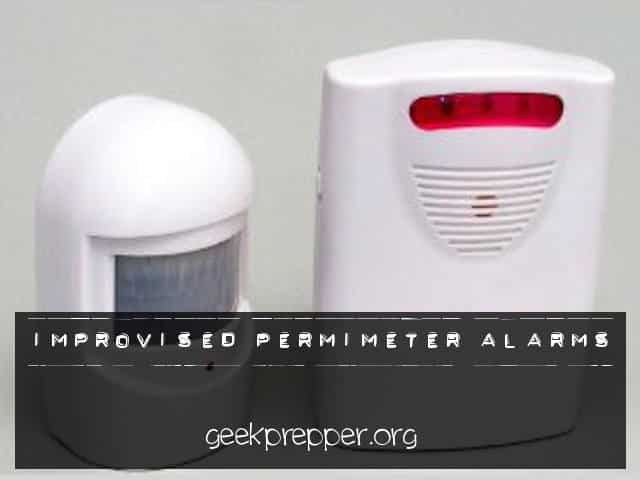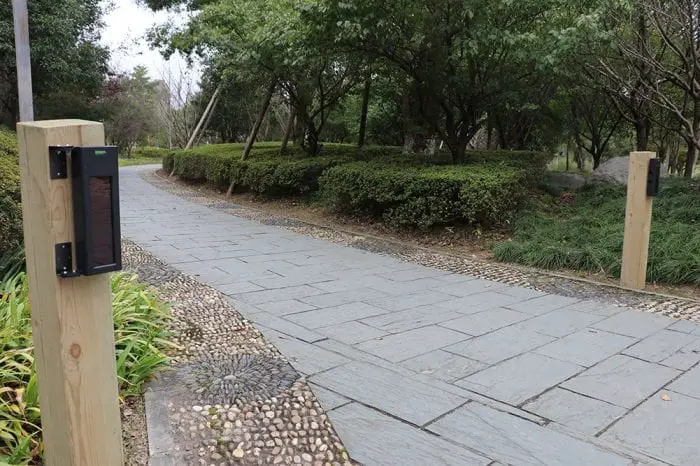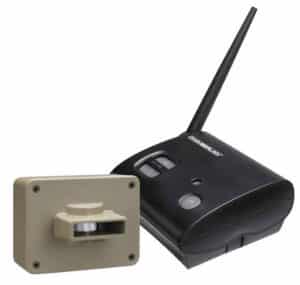What if it’s dark, or you’re asleep and someone is creeping up to your house?
This won’t happen if you have some improvised perimeter alarms.
Let’s dive in and see how easy it is to implement some different improvised alarm systems on a small budget.

Improvised Perimeter Alarms
In a survival scenario in which you can make it to your home, bugging in is often the best option. This means you have prepped and fortified your home so that you have the supplies you need, and you can defend your family.
Quick Navigation

However, a bug in situation can go south very quickly. If you have looters or other threats break down your front door without any warning, you can be sure things will not go well.
You need to know when somebody is entering your property or home, and a perimeter alarm system (aka early detection system) is the way to do it.
These can be incredibly complicated or incredibly simple. However you choose to set up your system, if you plan to bug in you need to be sure you have one.
In this article, we will cover the different ways you can detect intruders early and which options might work best for your home.
The Outer Perimeter

An ideal setup for bugging in is to have a decent amount of land surrounding your home.
This gives you a place to plant a garden and potentially hunt or fish for food. In addition, it also gives you an opportunity to set up several layers of perimeter alarms to alert you if you have an intruder. The first layer is the outer perimeter.
I will use our property as an example throughout this article. We have 10 acres surrounded by barbed wire. You want to have a system set up to let you know as soon as somebody crosses that property line.
We are surrounded by thick woods and dense brush, so there are only a few places where it would make sense for an intruder to enter our property.
At these choke points, you can place trail cameras. These are wireless cameras with motion detectors built-in. If you buy one with remote access, it can take a picture or video and send it to your phone so you can see who or what set off the camera.
You can also set up streaming video cameras at these points. This will allow you to watch live streaming video of the places where a person might enter the property.

If you want to go low tech, you still have some options. You can put motion detectors along with these entry points. These are either designed to sound an alarm in your home if they are tripped, or they can simply fire up a floodlight to illuminate the area.
Dogs are always a good outer perimeter alarm. Most dogs will know who is supposed to be on your property and who is not. When a stranger enters your property, a few good barks can alert you of their presence and can scare off the intruder. Finally, tripwires are good for outer perimeter alarms.
This is simply a string or fishing line strung across the choke point and attached to an alarm of some kind.
You can simply attach bells to the wire, or you can attach a more aggressive noisemaker like an explosive/firecracker or air horn. When a person trips on the wire it will sound the alarm and let you know they are coming.
In the woods, you can rig up some fishing line to your cooking gear or cans and fashion a trip wire alarm. For home security this doesn’t translate well, who really wants fishing line running around their yard and pots and pans in their yard?
A simple solution for this can be using driveway alarms as improvised perimeter alarms or an electronic tripwire!
If you aren’t familiar with driveway alarms, they consist of a tiny box that causes a remote chime to sound when something breaks it’s beam.
Benefits to these driveway alarms:
- Inexpensive
- Works up to 200 feet away
- Wireless installation
- Weather resistant
- Receiver chimes when sensor is crossed
One caveat to remember, if you want to cover multiple approaches, verify you can change channels on the sensors and the alerts they trigger. If not then try to get units from different vendors.
Otherwise you’ll end up with a single sound for all your regions, triggering all chimes (same frequencies) and will leave you unsure if the alert originated from the front of your property, the sides or or to the rear of your property.
This can be mitigated if the units have multiple frequencies and multiple alert chimes.
In direct sunlight these can be unpredictable. Also make sure to put them high enough that dogs, cats or woodland creatures don’t set them off and avoid aiming these units towards vegetation that can be moved by wind.
For an economic Improvised perimeter alarm (electronic tripwire), find yourself some driveway alarms, but make sure to read the reviews from other buyers to ensure that they will provide the quality you need and serve your purposes!
The Middle Ground
In between the edge of your property and your front door is what I like to call the middle ground. Many people forget about this area when it comes to setting up a perimeter alarm system.
However, this layer of protection is vital if you want as much notice as possible. Often an intruder will expect an alarm system at the edge of the property but will be surprised by one a little further in.
Some of the systems you may have used for the outer perimeter will work here as well.

Dogs will typically cover every square foot of your property, so they have the middle ground covered as well. Setting up game cams or motion detectors along the most obvious paths to your home is a good idea.
On our property, our driveway, the path from our pond, and the path from the barn are the most obvious places a person might walk. These are good choke points for setting up alarms. Tripwires are not ideal for this part of the property.
Between mowing and other activities, they would often get in the way. However, if I know we are going to be in a lockdown situation I can set them up very quickly.
The Building Perimeter
Your final line of defense before somebody enters the home is the building perimeter. This is the alarm system that will alert you right before or right as somebody is breaking into the home.
You can set this up yourself with some of the tools mentioned above, or you can have a modern alarm system installed. I like a combination of both. Let’s start with the modern alarm system.
Any more you can order and install your own alarm system for next to nothing. These alarms are set up to use cellular signals to alert the authorities if your alarm goes off, so cutting the phone lines will not disable the system.
They can also be set up to alert your cell phone if you are away from home when the alarm goes off. If you do not want to set this up yourself, you can hire a company to do it for you.

You want to be sure that your system is covering as many different entry points as possible. I like to see several video cameras both inside and outside the home covering windows and doors.
You can set up motion detectors outside the home to trip the alarm, and you can set them up inside the home as well.
You can install glass break alerts at all of the windows, so you know if somebody has tried to get in at that point. Finally, you can install door and window open sensors around the house.
These set off the alarm if they sense that a door or window has been opened after the alarm has been armed. If the system works properly, you should be aware the second an intruder tries to enter your home.

In addition, you can add to your building perimeter system using some tools we discussed above. You can add additional motion sensor lights along the outside of the home to fire up a floodlight when motion is detected.
If you are in a lockdown scenario, you can add trip wires near all of the entry points to your home. You can again use trail cameras specifically pointed at doors and windows but from outside the home.
Finally, I like to have an indoor dog and an outdoor dog if possible. This ensures that you also have a dog ready to alert you if somebody actually enters the home.

Of course, just being alerted about an intruder does not always solve the problem. Sometimes lights, alarms, and dogs will encourage an intruder to head back the way they came.
However, in large scale SHTF scenarios people will often ignore these deterrents. In addition, in large scale SHTF scenarios, your call to the police will often not help. Law enforcement gets bombarded with calls in situations like this.
It could be hours before they get to your home if they come at all. In addition, cellular service may be interrupted in certain scenarios so they may not get the call.
You should always have a defense plan for your family inside your home. This is a plan that states where everybody should go when an alarm goes off and what everybody should do. It is best to gather everybody in one room with a choke point like a hallway or staircase between yourselves and the intruder.
Next, you will need some way to defend your family when an intruder gets to this choke point. That could be a firearm, or it could be just a blunt object.
However, you plan to attack, have your weapon near this room and be ready to go. The purpose of the choke point is to limit the movement of attackers, so even if there are more than the one you should have a good shot at taking them down one at a time.

You do not necessarily need to set up your entire perimeter alarm system all at once. If you are tight on money or time, you can set up your system piece by piece.
Remember that any alert system is better than nothing. You can either start with your building perimeter system, or you can start with your outer perimeter system.
Whenever you have the time and money to add to your system, make the effort to improve it. You can be sure you will be glad that you did when things get rough.


How about a little audio to go along with it:
https://www.prepper-resources.com/outdoor-surveillance-with-condenser-microphones/
check out Dakota alerts. basically a murs radio that tells you there is movement. i also read about a diy solar powered motion sensor. the guy took a cheep motion sensor and wired in a red led in place of the buzzer. wired in two solar cells from a solar yard light. he put them around with the led pointed at the house( he also used a black painted straw as a light shield ) my thinking is that the Dakota alerts would alert you to a general area and the leds would pinpoint the threat.
We have the Bunker Hill unit featured on this page. The only drawback is it burns through batteries quickly, especially in cold weather.
Batteries: They do have a power adapter port, and you can also use rechargeables. My biggest concern with them is long-term durability. How is it?
I prefer 12 gauge trip alarms over electrical, if it’s an animal it’ll scare it away, if it isn’t he’s going to think twice on if that was a warning shot or not. Prices range from $20-30 and last forever if you have the ability to reload your own rounds.
Example(s): https://www.hitechammotogo.com/html/perimeter_alarm_systems___acce.html
And yes, there are .308 (compatible with 30.06 and .45 APC) versions around
How best to use these? Depends on where you are and what’s more valuable. Ideal to set up a dummy target away from you where you can move to higher ground/call for support while they track down where the shot came from.
Tape (you can glue it for more grip) fishing line to a light switch (preferably your bedroom light switch if you are sleeping) and tie the other end to a tree or pole.That way if someone triggers it, the light will turn on and you will know someone has trespassed.